-
Posts
2,284 -
Joined
-
Last visited
-
Days Won
6
Content Type
Profiles
Forums
Blogs
Gallery
Events
Store
Posts posted by PKeating
-
-
According to Bill Stump:
The badge I posted on the red background is a first type issued original. It is made in gold, platinum (some are made in 585 white gold) and real diamonds. The issued type are NOT produced by the Stubiger firm. The "IMIT" designates "imitation" stone and some same an imitation of the original. Himmler is seen wearing the "IMIT" wearing his wearing copy badge in many war time photographs. The wing configuration and design is the quickest way to distinguish the wearing copy from the issued badge. Here are examples of each from Wolfe and Hardin's collection.The badge shown by Bill Stump appears to be the badge offered for sale by War Relics. You can even see the abrasions to the rear of the wreath mentioned in the War Relics spiel. Yet the War Relics spiel was quite clear in its description of the hallmarks on the Dessloch B-St?ck badge. According to them, the Dessloch badge was made of silver and bore the IMIT marks, along with hallmarks for silver content, Vienna and the St?biger firm. Did Bill Stump get it wrong when he remembered Dessloch's badge as being made of gold and platinum?
PK
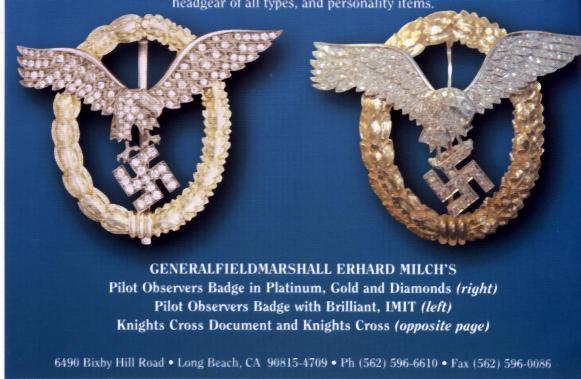
 0
0 -
A better version of the Dessloch photo.
PK
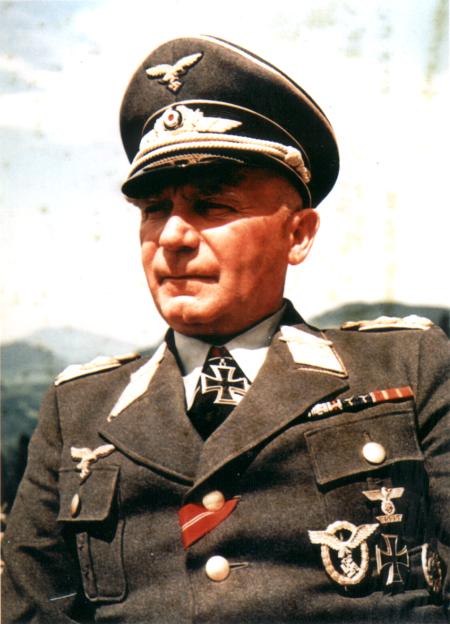
 0
0 -
Here is a snapshot, posted on the WAF years ago by the late Bill Stump, of the reverse of the Dessloch badge, which Bill stated was in Bob Hritz's collection. You can see the hallmarks to which the War Relics description refers, along with the abrasions where an attempt was made to obliterate the IMIT stamp on the wreath.
PK
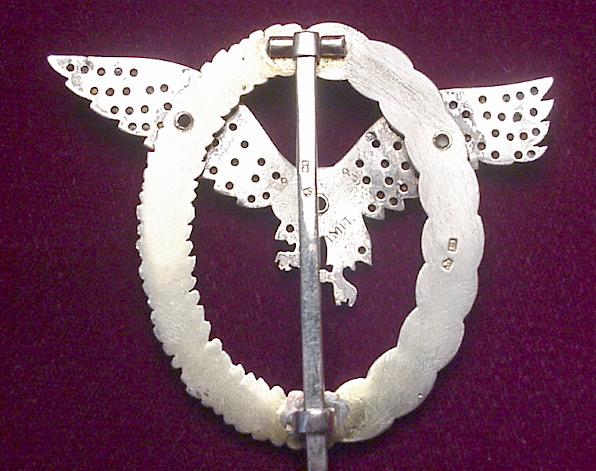
 0
0 -

Image from www.axishistory.com
Let's leave the A-St?ck badges for a while and have a look at the B-St?ck badges, which were made of gilded silver with cheaper stones. Here's a well known photograph of Generalleutnant Dessloch wearing a B-St?ck badge, identifiable here by the form of the pin. This badge was reportedly sold by www.warrelics.com for $12,500.00 US.

Here is the badge sold by War Relics. It has been denazified. Here is their spiel, which can be checked on http://www.warelics.com/gallery.html:
This, EXTREMELY RARE, and beautifully hand-crafted Luftwaffe Pilot/Observer badge with "diamonds", with period, expertly and professionally done, "denazification", or removal of the swastika, was the former property of Nazi Luftwaffe Generaloberst, Otto Dessloch, and comes with iron-clad documentation, and provenance, to that effect. The badge, and it's original, blue leatherette case, were given to USA(AF) LTCOL. William F. Woolley, by Luftwaffe GEN. Dessloch, following the end of WWII, after the two men struck up a friendship that continued for many years after the war. Apparently, LTCOL. Woolley and GENOBST. Dessloch were required to work together, after May, 1945, as liason officers in "denazifying", and repatriating, captured, former Luftwaffe officers. Following COL. Woolley's death, the badge and case were purchased by me, from his son, in the spring of 2001.It is thought that approximately fifty badges, of the actual 14K gold, and genuine diamonds type, were made, and awarded personally by Reichsmarschall HERMANN GOERING. The actual number made of GEN. Dessloch's, so-called "wearer's copy" type is not known, but probably numbers far less than the, Hermann Goering-presented, gold & diamonds type; making the former variety actually much, much RARER than the latter type.
The badge itself is made of sterling silver, which is hallmarked with Austrian silver "cartouche" stamps in the form of a swan, or pelican, in flight, and also struck with "IMIT", and the jeweller's logo (Wien 2), and name, "R. (Rudolf) Stubiger" (see pics). The beautifully designed, graceful, Luftwaffe eagle is handcrafted of sterling silver, and has the eagle's head and chest seperately riveted to the body (see pics). The eagle is fully encrusted with hand-set, "foilback" rhinestones, which display alot of "life", or sparkle. There are no stones missing. The eagle itself is attached to the oval, sterling silver, wreath by two hollow rivets (see pics). The wreath has about 30% of it's original gold wash remaining, and has some light scratching on the right side verso, near the pin housing (see pics), where someone apparently tried to sand-out the "IMIT" stamping in that area of the wreath. The extra-long, wide, flat pin is stamped with the Austrian silver content "cartouche" (vide supra), and the "Wien 2" logo. The original blue leatherette case, in which GEN. Dessloch kept his badge, when not in wear (see the color period photo of Dessloch wearing this ACTUAL badge in the pic section!), has the lid gold-embossed, "Fuhrer u.(und) Beobachterabz.", ("Pilot and Observer Insig."). The bottom of the fitted case is a dark blue velveteen material, with a vertical slot for the long pin, and the interior of the lid is lined in dark blue satin (see pics). The case hinge, and catch assembly, are magnetic (steel).
The documentation and provenance that accompany this RARE Luftwaffe Pilot/Observer Badge with Brilliants, is solid, complete, and irrefutable!!!! This actual badge was formally owned, and definitely
WORN (see color pic), by Luftwaffe Generaloberst OTTO DESSLOCH!
Further information regarding the documentation and provenance, which accompanies this beautiful and exciting piece, is available telephonically, or via electronic mail.
Comments?
PK
0 -
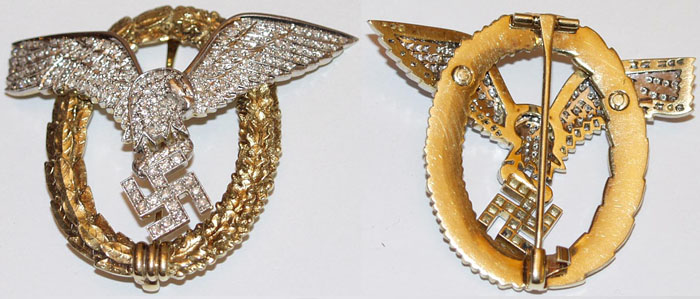
Courtesy of Dietrich Maerz - Image from Detlev Niemann's website
Is this badge, reportedly sold by Niemann for ?60,000.00, the same as the Hartmann and G?ring badges?
PK
0 -
Thank you, Chris, for posting the G?ring badge. I believe, if memory serves me correctly, that you acquired this from Eric Campion, who had acquired it along with other items from G?ring's estate back in the 1940s. Campion saved it from being broken up by Hatton Garden jewellers, didn't he?
Anyway, for the benefit of viewers, here are the G?ring and Hartmann badges side by side. It is quite clear that these are the same. One can see that the Rudel badge is also the same, the photograph notwithstanding. The unfortunate conclusion to be drawn is that the Sperrle, Skorzeny and Milch badges are fakes.
Rudel's awards were exhibited in a museum in London's Whitehall, set up by the "Porn King" Paul Raymond, and were the subject of quite a celebrated High Court case when Rudel's widow sued for their return. They had been stolen from Rudel after his surrender by a British Military Policeman.
PK
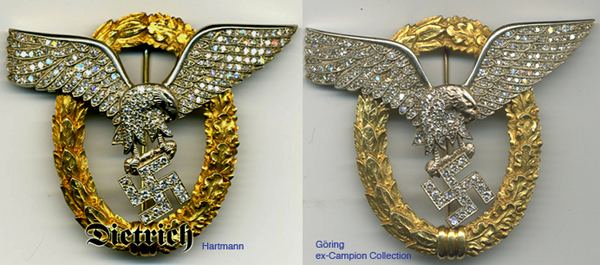
 0
0 -
Doesn't the Hartmann badge have the 14ct "585" hallmark?
PK
0 -
Kev,
The 1916 groups are from Whyte's website. I wish I had a 1916 medal. One of these days... I just have the War of Independence Service Medals. Speaking of which, I noticed the jump ring differences too. However, I have seen thick and thin jump rings on original War of Independence Service Medals in the hands of veterans or veterans? families. I think the eBay WISM is probably okay but it?ll be interesting to see what response you get. You?ll see an innocuous question there from me.
Regarding casualties in the Anglo-Irish War, or War of Independence, people are often surprised by the relatively low figures. Most historians appear to agree on a figure of around 1,400 on all sides. The Police Service of Northern Ireland, which is the heir via the RUC to the old RIC, lists 418 members of the Royal irish Constabulary killed, compared to 146 British solldiers. The IRA targeted the RIC more than the British Army because, for one things, the police weren?t as skilled in arms as trained soldiers and it was therefore easier to raid their barracks and, having suppressed resistance, make off with the contents of their armouries. The Civil War, in contrast, resulted in more than 4,000 deaths in just eleven months. It could have been a lot worse. Look at Spain, some fifteen years later: over a million people died, roughly a quarter of Spain?s population at the time. There again, the IRA volunteers who rebelled against the Treaty were under-equipped and no match for the Free State Army, which fought the rebels with extreme brutality, often taking no prisoners or else ensuring that prisoners taken didn?t live very long. My grandfather was sent to Cork to get a grip of the Free State units there after complaints were received in Dublin from prominent Cork people about the public torture and killing of IRA prisoners. A favourite method was to drag them to death behind trucks as the mob cheered. Setting fire to gasoline-soaked prisoners and taking bets on how long they remained standing or running about was another favourite too. Of course, if you bring this kind of thing up in a revisionist Ireland, where the only villains were the Black and Tans, people don?t like it. The IRA did some awful things as well. But they were more sinned against than sinners. The Treaty was only accepted because De Valera took Lloyd-George?s threat to flood Ireland with a million men-under-arms seriously. De Valera set Collins up to take the fall for it too. Mind you, Collins probably wouldn?t have made a good peacetime leader. He was too prone to resorting to violence to make his point.
Anyway...ancient history!
Paul,
Thanks for the clarification of the naming process. I?ll ask my aunt when the family applied for and received Dr Shannon?s medal. I know he died when she was quite young but he was certainly alive in the 1960s.
PK
0 -
I had the group for a a little while. I fondly entertained notions of using it as leverage to acquire an FJ-related RK group. As you know, I almost bought Rudolf Witzig's preliminary RK document for Eben Emael, along with his Kretaschild, a while back but was probably overly cautious and someone else got it, with my blessing. It went to the best home for it, to Heer FJ collector Numero Uno. Mind you, it sort of fitted in with my SS-FJ interest because Witzig's men fought alongside SS-Fallschirmjäger-Btl 500 in the Baltic in autumn 1944. No <i>Ritterkreuze</i> for the SS-FJ! Just an Ehrenblattspange for Drvar and a handful of DKiG for the Oderfront. One officer did get the RK but afterwards, after transferring to another unit. Still, I am a patient man. Something nice will turn up.
PK
0 -
I'll give you that, Bob! You're almost there. His last couple of victories were in <i>turbojäger</i>.
P
0 -

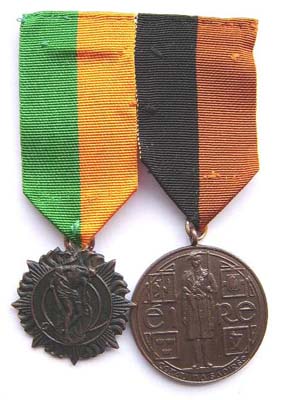
It certainly does look smaller than it should look beside the Independence medal. Well-spotted! It must be a cast copy. That would explain not just the fuzzy detail and pitting but the dodgy colour and the fact that it appears to be smaller than the known originals from the White's auction. The vendor might not know. I was looking at his other sales and he seems reasonable enough. It might be an old fake or copy. They've been faking these things since the 1966 anniversary. I think they also produced some copies then, cast from an original and sold as commemorative copies. If the story about finding them in the house in a tin is true, it's possible that some elderly Walt like the thousands who convinced the Irish government that they were eligible for the WISM mounted the fake 1916 medal with his non-combattant's WISM and posed down the pub. It's a bit like all the old gits here in France who tell you they were with la R?sistance. If the IRA had been as large as the medal roll and all those awards in the 1950s and 1960s suggest, the War of Independence would have over somewhat faster! LOL!
PK
0 -
The metal doesn't look right where that eBay 1916 medal is concerned. Perhaps it's due to oxidisation. Perhaps the lack of detail and the pitting are due to the medal having been "restored" by aggressive cleaning to remove verdigris, followed by chemical toning to try to make it look old again. Maybe the clown who mounted the medals like that cleaned it up? Just for interest, an officially named WISM with Comrac clasp. Dr Shannon was one of my great-uncles. I am told that officers' medals were issued named.
PK
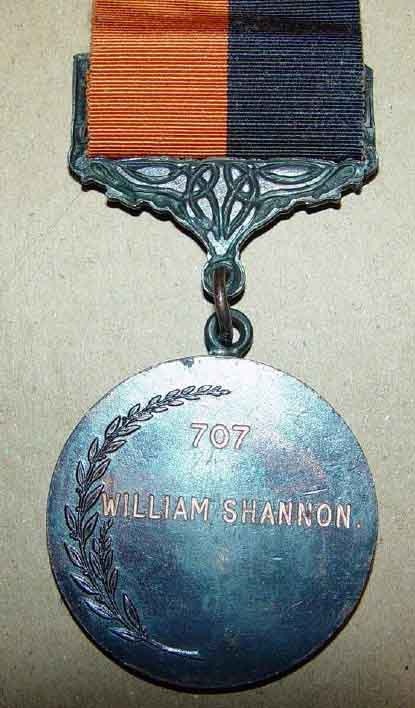
 0
0 -
The War of Independence Service Medal looks real at a glance but I share your doubts about the 1916 Medal. It looks neither like a period original nor one of the official reissues from the 1960s. I'm also a bit thrown by the tale about storage conditions that caused the original ribbons to disintegrate but had no apparent effect upon the medals. I'd also expect to see a Comrac clasp on the WISM although I am sure some non-combattant recipients qualified for the 1916 medal.
Are we getting too paranoid?
PK
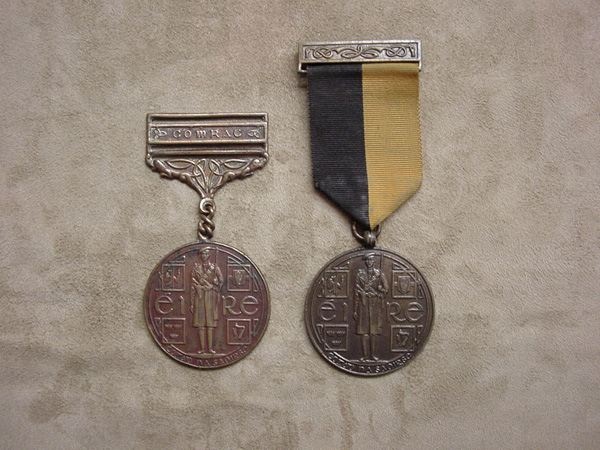
 0
0 -
Just as I was trying to qoute you it disappeared.
The badge did not come from the Hartmann family but from Hartmann directly, cased - with all the other awards and documents he got, including the Oakleaves with Swords and Diamonds. I know it is sometimes hard to believe that something might be real and genuine (especially such an award) but just try to do it this time. If you are looking for a genuine example, this is one!
There is an amusing symmetry to being teased for excessive caution by you. I reconsidered what I wrote after remembering hearing about Hartmann's disposal of his awards. As far as I can remember, Hartmann's badge looks just like Rudel's badge, which I handled many years ago. I believe that Adolf Galland acquired a copy of his badge sometime after the war.
Another question worthwile asking is why Goering would sub-contract the manufacture of an award to a foreign country - at least before the Anschluss? Maybe Stuebiger was not the supplier?No maker marks other than the gold content on the reverse - and no cut-outs on the outer wing frame.
That's an interesting theory about Rudolf St?biger. Dr Kurt Klietmann attributed the A-St?ck and B-St?ck badges to Rudolf St?biger and St?biger's son confirmed on more than one occasion that his father's firm produced them. Do you have another maker in mind?
Are you aware that when the RK Brillanten grade was instituted on 15.7.1941, Godet sub-contracted the setting of the diamonds to the Paris branch of the American firm of Tiffany? While G?ring was not involved in this, it shows that the German government of the day had no problems with commissioning foreign firms to carry out work for them. Another American firm known as IBM supplied the Gestapo with the filing system that enabled the Final Solution. The RK Brillanten contract was then given to Klein, probably because G?ring made such a scene about what he saw as the low quality of the diamonds used in the prototypical and early pieces supplied by Godet.
I don't see why Hermann G?ring would balk at having his PO Badge with Diamonds award produced by an Austrian jeweller in 1935. He was quite a cultivated man and very old school. Some of the best European Art Deco jewellery came out of Vienna, which had a long tradition of fine jewellery dating back to Hapsburg times. G?ring's F?hrer was Austrian. The unification of Germany and Austria was already on the cards. There was a lot of commerce between the two countries. What would have prevented Hermann G?ring from commissioning Herr St?biger?
PK
0 -
I agree with Christopher Ailsby. Christopher raised a good point in a PM to me, which I know he shan't mind my repeating here: the badges were supposed to be returned to G?ring's office upon the death of the recipient so why would a recipient have one engraved? There again, SS Honour Rings were supposed to be returned upon the recipient's death but were awarded engraved. However, these badges do not appear to have been awarded engraved so having them privately engraved would surely amount to vandalism of the Reichsmarschall's property.
PK
0 -
The Hartmann badge certainly embodies the features and finesse I recall from handling a couple of originals many years ago.
PK
0 -
Just as a matter of interest, how do you know the Hartmann badge is genuine? If it really can be established as a genuine period example by Rudolf St?biger, that suggests that the three badges attributed here to Erhard Milch, Otto Skorzeny and Hugo Sperrle are all fakes. However, the young St?biger was apparently quite adamant that these badges were hallmarked. I believe that it would have been illegal not to do so but perhaps I am wrong.
PK
0 -
They are all different, period. As for badges shown here that appear to be silver-gilt, they look nothing like the original B-St?ck badges, which bore hallmarks and the letters "IMIT" on the reverse. The Skorzeny ensemble was listed on Manion's with a reserve of $54,000.00 US. I know that a couple of people were recently involved in producing high end fakes of the PO Badge with Diamonds, using gold and platinum, but I haven't seen one of these fakes or, rather, am not aware of having seen one. Perhaps there is one shown in this topic...
PK
0 -
Milch and Hartmann. I see various detail differences when studying, for instance, the leaves and the eagles' wings.
PK

 0
0 -
Herr St?biger's recollections might not be reliable. However, before we get into the question of hallmarks, let's compare the Hartmann and Skorzeny pieces side-by-side. It would be better without your name obscuring key details. I understand your reasons and I have also started putting watermarks and copyright notices on my images but you could perhaps use thinner letters. The image would remain protected but more visible. However, the fact is that these two badges came from different moulds. They are simply not the same.
PK
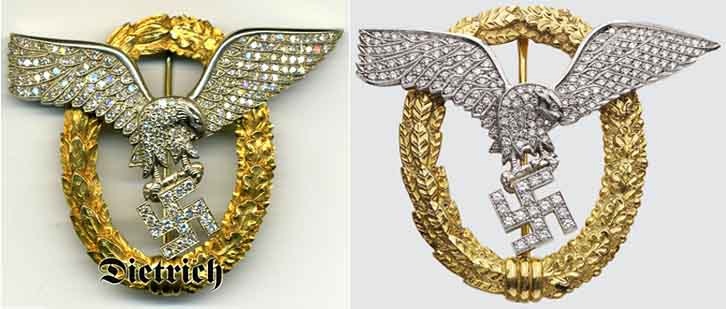
 0
0 -
G?ring commissioned these badges from Rudolf St?biger, a Viennese jeweller. According to Christopher Ailsby's book A Collector's Guide to World War 2 German Medals and Political Awards, St?biger's son stated that the firm produced seventy badges in total. As with certain other firms in Germany and Austria, one must presume that the St?biger firm was approached after the war by people asking them to reproduce these badges. They certainly responded to enquiries about the badges. St?biger fils apparently said that the early badges had the "shop number" scratched under the hinge, much as a watchmaker marks a watch upon which he has worked. After Austria was united with Germany in 1938, the firm stamped their logo "R.St." on the reverse of the eagle. St?biger reportedly described the eagles as made of platinum and the wreaths of 22 ct gold, which is the purest form of gold one can use for jewellery as 24 ct gold bends as easily as lead. 22 ct gold is still quite soft but stable enough for the purpose. The Skorzeny badge bears a 14 ct gold hallmark under the hinge and no mark of any kind is visible on the reverse of the eagle. St?biger Jr recalled that the silver-gilt dress copies were made in the same way as the award badges and bore hallmarks relating to the silver grade, manufacturer and place of manufacture, plus the letters "IMIT" stamped into the wreath. If the younger St?biger's recollections are reliable, the Milch badge pictured would appear to be a post-1938 example, which is interesting, given the award date engraved on the reverse.
PK
0 -
Here is Skorzeny's CV, from his personnel file, written in his own hand. The 1938 CV accompanying the badge and its document could be genuine but I thought I might as well post this. I find it quite interesting that the engraving on the reverse of the Skorzeny badge resembles Skorzeny's handwriting. Maybe Skorzeny, taking it to be engraved himself afterwards as Hermann G?ring probably didn't have the time, what with the mad rush to get the train out for the trip to Eastern Prussia, wrote down his name and rank on the order form and the engraver presumed that he should copy the style.
PK
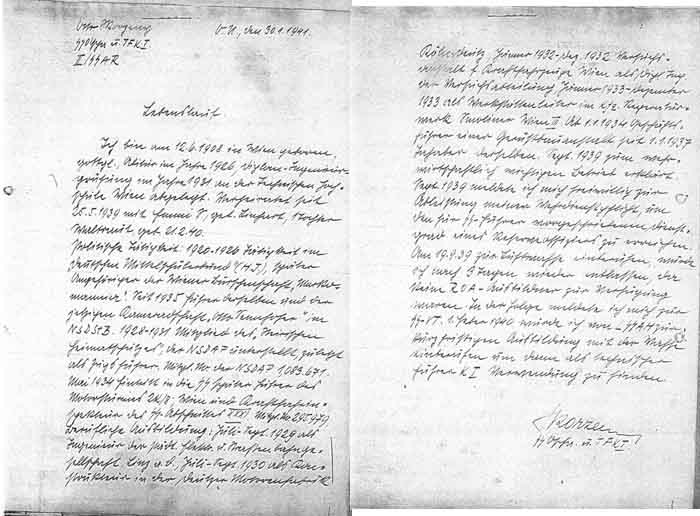
 0
0 -
Here is a photocopy of a document from Otto Skorzeny's personnel file. It is the second page of a report to the Reichsf?hrer-SS regarding the confirmation of Skorzeny's DKiG for Unternehmen Panzerfaust in October 1944. You can see the date of his EK1 and Ritterkreuz for the Gran Sasso mission: 12.9.43. Note the date given for the award of the "Flg.Abz.in Gold": 1.12.44. Yet the award document accompanying the above badge is dated 16.9.1943.
In Charles Foley's book Commando Extraordinary, based on Foley's interviews with Skorzeny in Spain a year or so after the latter's escape from British custody, reference is made to G?ring presenting Skorzeny with the "Gold Medal of the Airforce" at Rastenburg when Skorzeny visted Hitler there shortly after the Gran Sasso rescue mission. However, Dr Kurt Klietmann's essay on the badge, in his seminal reference work on Third Reich awards, gives the time of the award to Skorzeny of the Gemeinsames Flugzeugf?hrer und Beobachterabzeichen in Gold mit Brillanten as autumn 1944. This ties in with the date given in the report to Himmler from a Brigadef?hrer on the Reichsf?hrer's personal staff. I always thought Skorzeny was awarded the badge by G?ring after Panzerfaust, the Nazi-sponsored coup d'?tat led by Skorzeny in Hungary in October 1944. I tend to place more faith in the facts as recorded by the SS-F?hrungs-Hauptamt and the office of the Reichsf?hrer-SS.
While this might seem a bit of a red herring, it is worth pointing out that in his book on German medals and badges, Christopher Ailsby quotes a letter to a militaria magazine from Andrew Mollo back in 1981. Mollo expressed his belief that there were three grades of the Combined Pilot-Observer Badge: the basic award, the Diamonds award and a solid gold type which, according to Mollo, was awarded by G?ring to King Boris of Bulgaria and Benito Mussolini. Mollo also contended that Himmler received this solid gold class and suggested that it was subsequently upgraded with diamonds. Himmler received the Diamonds PO Badge in July 1942 and the award was instituted in 1935, the first two being given to Wever and Milch. No solid gold PO Badge without Diamonds from the 1935-1945 period has ever been observed. The confusion might have arisen because of contemporary references like Skorzeny's recollection of "gold airforce medals" and file entries like the one I have shown here. There again, perhaps someone intended to introduce a solid gold badge into the marketplace back in 1981...
Regarding the award document, I would expect to see an embossed seal on a document related to an award conceived by and in the personal gift of Hermann G?ring, in the manner of similar documents for awards like the Ehrenpokal. But, hey, what do I know? I'm just a document collector and amateur historian with a cold-eyed, investigative journalistic approach to establishing facts.
PK
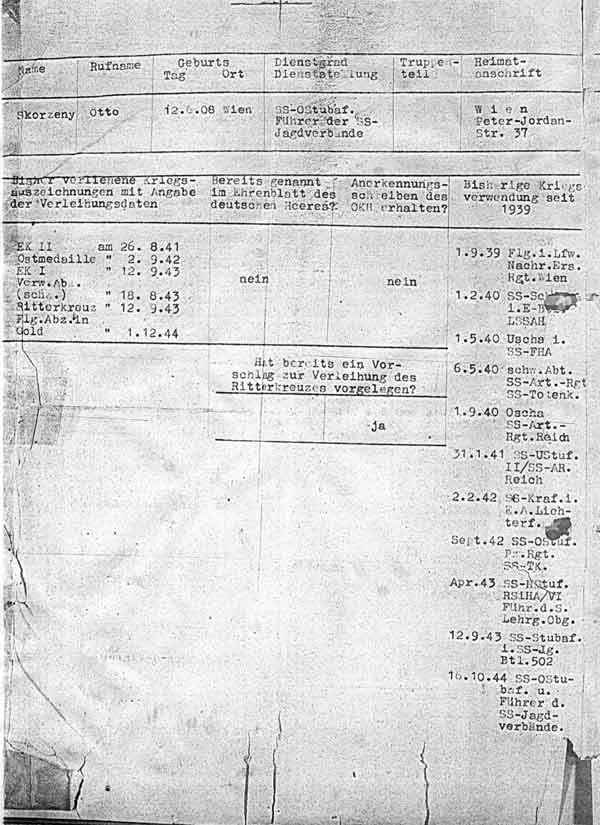
 0
0 -
Side-by-side comparison of the badges spanning the 1935 - 1943 timeline. As Rick (Stogieman) points out, there appear to be some major differences. These badges were made by jewellers but the main components were cast and ought to resemble each other in terms of surface detailing, differences due to hand-chasing and finishing around the edges apart. The same goes for the gold awards as well as the wearing copies said to have been given to recipients at the award ceremonies. I am also quite suspicious of the Skorzeny ensemble and would want verifiable provenance, especially if spending that kind of money with an institution noted for selling Hitler cigarette boxes and onyx-centred 1939 Grand Crosses.
PK

 0
0




Rare piece to be auctioned.
in Germany: Third Reich: Wehrmacht Medals, Decorations & Awards
Posted · Edited by PKeating
This "Milch" badge doesn't look much like the Wolfe-Hardin "Milch" badge, does it? But is the Wolfe-Hardin "Milch" A-St?ck badge the same as the Hartmann, G?ring and Rudel badges?
PK